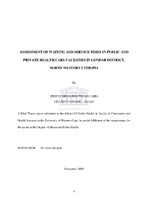| dc.contributor.advisor | Reagon, Gavin | |
| dc.contributor.author | Tegabu, Zegeye Desalegn | |
| dc.contributor.other | School of Public Health | |
| dc.contributor.other | Faculty of Community and Health Sciences | |
| dc.date.accessioned | 2014-02-05T11:24:53Z | |
| dc.date.available | 2010/06/02 02:20 | |
| dc.date.available | 2010/06/02 | |
| dc.date.available | 2014-02-05T11:24:53Z | |
| dc.date.issued | 2008 | |
| dc.identifier.uri | http://hdl.handle.net/11394/2717 | |
| dc.description | Magister Public Health - MPH | en_US |
| dc.description.abstract | The development and provision of equitable and acceptable standard of health services to all segments of the population has been the major objective of the 1993 Ethiopian National health policy. However, community based studies on satisfaction with public health care facilities reveal that the majority of the population are not satisfied with the services provided predominantly as a result of the long waiting times. Studies done on private health facilities on the contrary reveal that patients are satisfied with the service delivered within short waiting times in these clinics. Even though the speculated waiting time is thought to be long among the public health care facilities and short in private clinics, the actual waiting and service times have not been measured and compared. Aim: To determine the waiting and service times among the public and private health care facilities and measure the perceptions of 'acceptable' waiting time among the providers and clients. Materials and methods: A cross sectional observational study using quantitative techniques was carried out amongst patients and staff at selected public and private health care facilities in Gondar District. Stratified sampling method was used to select facilities. All patients visiting the selected facilities and all staff who provided service to patients on the day of the study were included in the time-delimited sample. Data was collected by research assistants and health workers from all patients attending the health care facility by registering the arrival and departure time of each patient to the facility and to each service point on a patient flow card. Then data was cleaned and captured by a specific Waiting and Service Time database. Descriptive statistics was done on waiting and service times for each facility and this was summarized for each public and private health facility by using tables and graphs. Finally a comparison was made for private and public health facilities by using Wilcoxon-mann-whitney non parametric tests. | en_US |
| dc.language.iso | en | en_US |
| dc.publisher | University of the Western Cape | en_US |
| dc.subject | Ethiopia | en_US |
| dc.subject | Waiting times | en_US |
| dc.subject | Service times | en_US |
| dc.subject | Quality of care | en_US |
| dc.subject | Public health care | en_US |
| dc.subject | Private health care | en_US |
| dc.subject | Waiting time norms | en_US |
| dc.subject | Patient satisfaction | en_US |
| dc.subject | Efficiency | en_US |
| dc.subject | Effectiveness | en_US |
| dc.title | Assessment of waiting and service times in public and private health care facilities in Gondar district, North western Ethiopia | en_US |
| dc.type | Thesis | en_US |
| dc.rights.holder | University of the Western Cape | en_US |
| dc.description.country | South Africa | |

